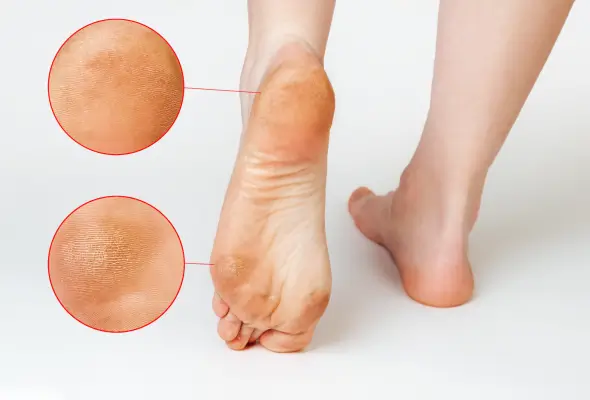-
Doctors
-
Specialities & Treatments
Centre of Excellence
Specialties
Treatments and Procedures
Hospitals & Directions HyderabadCARE Hospitals, Banjara Hills CARE Outpatient Centre, Banjara Hills CARE Hospitals, HITEC City CARE Hospitals, Nampally Gurunanak CARE Hospitals, Musheerabad CARE Hospitals Outpatient Centre, HITEC City CARE Hospitals, Malakpet
HyderabadCARE Hospitals, Banjara Hills CARE Outpatient Centre, Banjara Hills CARE Hospitals, HITEC City CARE Hospitals, Nampally Gurunanak CARE Hospitals, Musheerabad CARE Hospitals Outpatient Centre, HITEC City CARE Hospitals, Malakpet Raipur
Raipur
 Bhubaneswar
Bhubaneswar Visakhapatnam
Visakhapatnam
 Nagpur
Nagpur
 Indore
Indore
 Chh. Sambhajinagar
Chh. SambhajinagarClinics & Medical Centers
Book an AppointmentContact Us
Online Lab Reports
Book an Appointment
Consult Super-Specialist Doctors at CARE Hospitals

Corns on Feet
Symptom, Causes, Diagnosis and Treatment
Corns on Feet
Corns are distinct areas of thickened skin that develop primarily on the feet in response to persistent pressure or friction. These hardened skin lesions, medically known as "clavus" or "heloma," form protective barriers but often become painful over time.
Three main types of corns affect different areas of the feet:
- Hard Corns (Heloma Durum): These small, dense areas typically form on the top or sides of toes, particularly where bone pressure meets skin. Hard corns appear as round, raised bumps surrounded by irritated skin.
- Soft Corns (Heloma Molle): These whitish-grey lesions develop between toes, particularly in the fourth toe space. Soft corns have a rubbery texture and can resemble open sores. The moist environment between toes makes these corns prone to bacterial or fungal infections.
- Seed Corns: These small corns manifest as multiple keratotic plugs within plantar calluses, commonly appearing on non-pressure-bearing areas of the soles.
Though corns serve as protective mechanisms, they should be regarded as symptoms rather than diseases, often indicating underlying biomechanical issues or inappropriate footwear choices.

Symptoms of Corns
The most noticeable symptom appears as a small, round, raised bump of hardened skin surrounded by irritated tissue. These bumps commonly develop a dense core, which presses on the nerves beneath the skin surface.
Pain patterns associated with corns include:
- Discomfort when wearing shoes
- Increased tenderness upon direct pressure
- Sharp pain from the central core pressing against nerves
- Heightened sensitivity in the surrounding skin area
The distinction between corns and calluses becomes apparent through their symptoms. Calluses present as larger, flattened patches of thickened skin with reduced sensitivity compared to the surrounding tissue. On the other hand, corns remain smaller, deeper, and generally more painful due to their concentrated core.
What Causes Corns on Feet?
The primary cause stems from repeated mechanical trauma to specific areas of the skin. This persistent pressure triggers the body's protective response, producing excess horny epithelial layer to prevent skin ulceration.
Ill-fitting footwear ranks as the most common culprit behind corn development. Shoes that squeeze the toes or create excessive friction against specific foot areas and high-heeled shoes place substantial downward pressure on the feet.
Several risk factors increase the probability of developing feet corns:
- Foot Structure and Medical Conditions:
- Bone deformities from birth
- Bunions and hammertoes
- Arthritis affecting foot alignment
- Fat pad atrophy, particularly common in elderly individuals
- Lifestyle and Footwear Choices:
- Walking barefoot regularly
- Not wearing socks with shoes
- Standing or walking for extended periods
- Improper walking posture, particularly favouring foot edges
- Loose sock linings that bunch under feet
- Older individuals face higher risks
- Individuals with darker skin pigmentation show increased susceptibility
- Sports activities, manual labour, or any pursuit that creates repeated friction on specific foot areas
- The presence of bunions often leads to corn development
Complications of Corns
Several serious complications can develop from neglected corns:
- Bursitis: Inflammation develops in the fluid-filled sacs between skin and bone, requiring antibiotic treatment. In certain cases, doctors must drain the fluid and administer steroid injections.
- Septic Arthritis: When corn becomes infected, bacteria can travel through the bloodstream, affecting one or more joints. This condition manifests through intense joint pain, redness, swelling, and restricted movement.
- Osteomyelitis: Bacterial spread from infected corns can affect bone tissue and nearby tendons. This condition predominantly affects smokers and individuals with diabetes, primarily because of poor foot circulation.
Diagnosis of Corns
Medical assessment typically involves several key steps:
- Physical Examination: Doctors examine the skin's response to physical trauma and assess the texture through palpation. The examination includes checking for flesh-coloured, dry, hard papules over bony prominences.
- Walking Assessment: Doctors observe patients' gait patterns to identify irregular mechanics that might contribute to corn formation. This assessment helps determine underlying biomechanical issues causing pressure points.
- Footwear Analysis: Doctors evaluate patients' shoes and discuss their daily activities, including standing and walking habits. This information helps identify potential causes and guides treatment recommendations.
What is the Treatment for Corn on Foot?
For mild cases, soaking feet in warm water softens the hardened skin, making removing it easier. After a 10-minute soak, gently filing the corn with a pumice stone helps eliminate dead skin layers. Following this process, applying a moisturising lotion containing salicylic acid aids in gradually softening stubborn corn.
- Medical treatment:
- Manual Removal: Doctors perform gentle paring without drawing blood, utilising scalpels under local anaesthesia when necessary
- Topical Treatments: Keratolytic medications, including salicylic acid, urea, and silver nitrate, effectively soften corn
- Laser Therapy: The laser offers minimal thermal tissue damage during corn removal
- Surgery: Surgical intervention becomes necessary under specific circumstances:
- Failed conservative treatments
- Structural foot deformities causing recurring corns
- Extremely painful lesions
- Recurring infections
- Protection plays a vital role in treatment success:
- Donut-shaped adhesive pads shield corns from shoe pressure
- Proper footwear with increased toe width prevents friction.
- Keeping toenails properly trimmed further reduces pressure on the toes.
- Diabetes or compromised circulation increases infection risks, making self-treatment potentially dangerous.
- Similarly, those experiencing signs of infection, including worsening pain, pus, or swelling, should seek immediate medical attention.
When to See a Doctor
Doctor evaluation becomes essential under these conditions:
- Persistent pain despite home treatments
- Signs of infection, including:
- Redness around the affected area
- Swelling or inflammation
- Discharge or pus formation
- Intense discomfort while walking
Medical consultation becomes imperative for people with:
- Underlying diseases - increasing infection risks
- Delicate skin conditions
- Failed home treatment attempts
- Abnormal bone structure or alignment issues
Conclusion
Corns might seem like minor foot problems, though they can significantly impact daily life when left untreated. These hardened skin formations serve as warning signs of underlying foot issues that require attention. Doctor medical care becomes essential, particularly for people with diabetes or circulation problems.
The proper treatment approach depends on individual circumstances and corn severity. Simple cases often respond well to proper foot care and appropriate footwear changes. However, severe cases might need medical intervention, including surgical procedures that show high success rates.
Therefore, anyone experiencing persistent corn-related discomfort should prioritise proper foot care and seek medical help when needed.
FAQs
1. How do you get rid of corn on your foot?
Removing corn involves a systematic approach combining self-care methods and professional treatments. First, soak your feet in warm water for 5-10 minutes until the skin softens. After soaking, use a pumice stone with gentle circular motions to remove dead skin. Apply moisturising cream containing salicylic acid, ammonium lactate, or urea to soften the hardened areas gradually.
2. What is the leading cause of corns on feet?
The fundamental cause stems from repeated friction and pressure on specific areas of the feet. Ill-fitting footwear ranks as the primary culprit, creating constant pressure points where corns develop. Bone deformities, arthritis, and improper walking patterns intensify the risk of corn formation.
3. What will happen if corn is left untreated?
Untreated corns can trigger severe complications. The affected area might develop bacterial infections, potentially spreading to joints (septic arthritis) or nearby bone tissue (osteomyelitis). Individuals might unconsciously alter their walking pattern to avoid pain, leading to posture and alignment issues affecting the back and knees.
4. Will a corn go away by itself?
Most corns gradually disappear once the source of pressure or friction stops. Still, corns typically return without addressing the underlying cause, such as poorly fitted shoes. Combining proper footwear with appropriate treatment methods ensures effective corn management for optimal results.
5. Is corn a serious disease?
Although corns are not diseases, they can indicate underlying foot problems requiring attention. For individuals with diabetes, corns present significant risks. Diabetic patients might not detect minor cuts or small corns promptly due to reduced sensation in their feet, potentially leading to severe complications, including tissue death (gangrene). Furthermore, untreated corns can spread into surrounding skin, eventually cracking and creating entry points for infections.
Still Have a Question?


